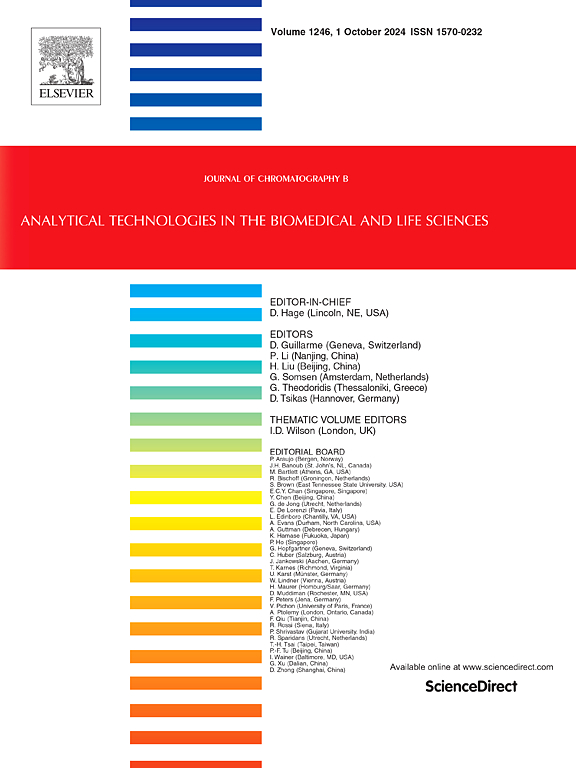结合多种LC-MS方法对重组带状疱疹疫苗进行综合表征
IF 2.8
3区 医学
Q2 BIOCHEMICAL RESEARCH METHODS
引用次数: 0
摘要
据报道,重组带状疱疹(HZ)疫苗是减少带状疱疹负担和相关并发症的最有效策略。为了确保重组HZ疫苗的质量、安全性和有效性,对其抗原重组糖蛋白E (RgE)的全面表征至关重要。然而,由于RgE的极端复杂性和异质性,单一的分析平台不足以进行全面的表征。本研究开发了一种创新的基于LC- ms的工作流程,该流程结合了多种平行蛋白酶酶切、各种分离技术(纳米流LC、高流量LC和天然分离)、高分辨率质谱(HR-MS)和多种离子活化方法,实现了对RgE的全面分析。结果,通过ethcd诱导的LC-MS/MS鉴定了21和21个o -糖基化和磷酸化位点。两个n -糖基化位点(N207和N406)被不同的n -聚糖鉴定。N207最丰富的n -聚糖是A2S2F。鉴定了N406的前5个n -聚糖。此外,RgE还检测到5个二硫键。分别为cys195 ~ cys205、cys401 ~ cys411、cys177 ~ cys189、cys365 ~ cys374、cys356 ~ cys382。对于宿主细胞蛋白(HCP)分析,采用高灵敏度的纳米LC-MS/MS方法,鉴定了50种宿主细胞蛋白(HCP),包括2种高危蛋白,clusterin和peroxredoxin -1。此外,在天然和变性条件下获得的分子量测量结果与肽图谱获得的氨基酸序列一致。在使用RgE优化LC-MS工作流程之后,该方法被应用于评估通过不同生产工艺生产的重组带状疱疹疫苗。结果表明,该工作流程对新的重组带状疱疹疫苗的表征非常有效,也可以作为开发其他复杂重组疫苗的有价值的工具。本文章由计算机程序翻译,如有差异,请以英文原文为准。
A combination of multiple LC-MS approaches for the comprehensive characterization of recombinant herpes zoster vaccine
Recombinant herpes zoster (HZ) vaccines were reported as the most effective strategy to reduce the burden of herpes zoster and related complications. To ensure the quality, safety, and efficacy of recombinant HZ vaccines, comprehensive characterization of its antigen, recombinant glycoprotein E (RgE), is critical. However, due to the extreme complexity and heterogeneity of RgE, a single analytical platform is insufficient for comprehensive characterization. This study developed an innovative LC-MS-based workflow that combines multiple-parallel-protease digestion, various separation techniques (nano-flow LC, high-flow LC, and native separation), and high-resolution mass spectrometry (HR-MS) with multiple ion activation methods to achieve a comprehensive analysis of RgE. As a result, 21 and 21 O-glycosylation and phosphorylation sites were identified by EThcD-induced LC-MS/MS. Two N-glycosylation sites (N207 and N406) were identified with various N-glycans. The most abundant N-glycan for N207 was A2S2F. The top five N-glycans detected for N406 were also identified. Additionally, five disulfide linkages were detected for RgE. They were Cys 195-Cys 205, Cys 401-Cys 411, Cys 177-Cys 189, Cys 365-Cys 374, and Cys 356-Cys 382. For host cell protein (HCP) analysis, a high-sensitivity nano LC-MS/MS approach was applied, identifying 50 host cell proteins (HCPs), including two high-risk proteins, clusterin and peroxiredoxin-1. Additionally, molecular weight measurements obtained under both native and denatured conditions agreed well with the amino acid sequence acquired by peptide mapping. Following the optimization of the LC-MS workflow using RgE, the method was applied to evaluate recombinant zoster vaccines produced through different manufacturing processes. The results demonstrated that this workflow is highly effective for characterizing new recombinant zoster vaccines and may also serve as a valuable tool for the development of other complex recombinant vaccines.
求助全文
通过发布文献求助,成功后即可免费获取论文全文。
去求助
来源期刊

Journal of Chromatography B
医学-分析化学
CiteScore
5.60
自引率
3.30%
发文量
306
审稿时长
44 days
期刊介绍:
The Journal of Chromatography B publishes papers on developments in separation science relevant to biology and biomedical research including both fundamental advances and applications. Analytical techniques which may be considered include the various facets of chromatography, electrophoresis and related methods, affinity and immunoaffinity-based methodologies, hyphenated and other multi-dimensional techniques, and microanalytical approaches. The journal also considers articles reporting developments in sample preparation, detection techniques including mass spectrometry, and data handling and analysis.
Developments related to preparative separations for the isolation and purification of components of biological systems may be published, including chromatographic and electrophoretic methods, affinity separations, field flow fractionation and other preparative approaches.
Applications to the analysis of biological systems and samples will be considered when the analytical science contains a significant element of novelty, e.g. a new approach to the separation of a compound, novel combination of analytical techniques, or significantly improved analytical performance.
 求助内容:
求助内容: 应助结果提醒方式:
应助结果提醒方式:


